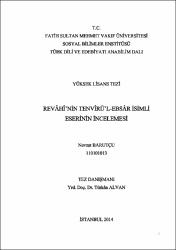| dc.contributor.advisor | Alvan, Türkân | |
| dc.contributor.author | Barutçu, Nevzat | |
| dc.date.accessioned | 2014-05-26T14:30:13Z | |
| dc.date.available | 2014-05-26T14:30:13Z | |
| dc.date.issued | 2014 | |
| dc.identifier.citation | BARUTÇU Nevzat, Revahi’nin Tenvirü’l-Ebsar isimli eserinin incelenmesi, Fatih Sultan Mehmet Vakıf Üniversitesi Sosyal Bilimler Enstitüsü Türk Dili ve Edebiyatı Anabilim Dalı, Yayımlanmamış Yüksek Lisans Tezi, İstanbul 2014 | en_US |
| dc.identifier.uri | https://hdl.handle.net/11352/1907 | |
| dc.description.abstract | Osmanlı İmparatorluğu’nda XVI. yüzyılın ikinci yarısından itibaren başlayan dönem, duraklama dönemi olarak bilinir. Bu dönemde birçok alanda duraklamaya başlayan Osmanlı coğrafyasında edebiyat ve sanat gelişmeye devam etmiş, pek çok önemli şahsiyet yetişmiştir. Gücünü İslâmiyet’ten alan İslâmî Türk Edebiyatı, hem içtimaî hem de dînî konularda gerekli yetkinliğe ulaşmakla birlikte bu alanda birçok telif eserin yanında tercüme eserler de kaleme alınmıştır. Âyet ve hadis, özellikle de kırk hadis, tercüme ve şerhleri İslâmî Türk Edebiyatında yer alan dinî türler içerisinde en çok işlenen tür olmuştur.
“Revâhî’nin Tenvîrü’l-Ebsâr İsimli Eserinin İncelemesi” adlı çalışmamızda bir kırk âyet-kırk hadis tercümesi olan Tenvîrü’l-Ebsâr çeşitli yönlerden incelenmiş ve bu inceleme neticesinde de söz konusu alana bir katkıda bulunmak amaçlanmıştır.
Üç bölümden oluşan çalışmamızın birinci bölümünde Tenvîrü’l-Ebsâr nazım şekilleri yönünden incelenmiş ve eserin vezni tespit edilmiştir. Çalışmanın ikinci bölümünde muhtevâ bakımından bir inceleme yapılmış ve tezin üçüncü bölümü el yazması metnin transkripsiyonu ile tıpkıbasımına ayrılmıştır. Ayrıca araştırmacıların istifadesine sunulmak amacıyla çalışmaya dizin eklenmiştir.
The time period that began in the second half of the 16th century is known as the stagnation period of the Ottoman Empire. While many things came to a halt in this period, literature and art continued to develop and many important personalities were raised. Backed by Islam, Islamic Turkish literature reached in its maturity in social and religious themes and several books and translations were penned. The translation of and the commentary on the Qur’anic verses and the hadith (the utterances of the Prophet Muhammed), especially the Forty Hadith, were the most used ones among the themes that are peculiar to the Islamic Turkish literature.
In this study which is titled as “A Survey on Revâhî’s Tenvîrü’l-Ebsâr,” I aimed to contribute to the field of Islamic Turkish literature by examining Tenvîrü’l-Ebsâr, which is a translation of the Forty Hadith.
This study has three chapters. The first chapter addresses the poetic qualities and the meter of Tenvîrü’l-Ebsâr. The second chapter deals with the content of the work. And finally the third chapter is devoted to the transcription of the manuscript and it’s facsimile. And for the use of researchers, an index is added to the end of the survey. | en_US |
| dc.language.iso | eng | en_US |
| dc.publisher | FSM Vakıf Üniversitesi | en_US |
| dc.rights | info:eu-repo/semantics/openAccess | en_US |
| dc.subject | Revahi | en_US |
| dc.subject | Tenvirü’l-Ebsar | en_US |
| dc.subject | İslami Türk Edebiyatı | en_US |
| dc.subject | Kırk Ayet-Kırk Hadis | en_US |
| dc.subject | Tercüme | en_US |
| dc.subject | Islamic Turkish Literature | en_US |
| dc.subject | The Forty Verses-Forty Hadith | en_US |
| dc.subject | Translation | en_US |
| dc.subject | Illumination of the Eyes/Vision | en_US |
| dc.title | Revahi’nin Tenvirü’l-Ebsar isimli eserinin incelenmesi | en_US |
| dc.type | masterThesis | en_US |
| dc.contributor.department | FSM Vakıf Üniversitesi, Sosyal Bilimler Enstitüsü | en_US |
| dc.relation.publicationcategory | Tez | en_US |
| dc.contributor.institutionauthor | Barutçu, Nevzat | |



















